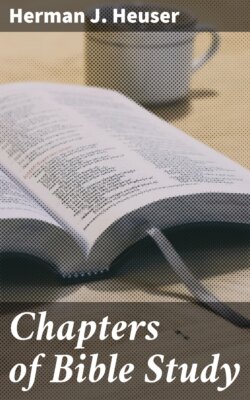Читать книгу Chapters of Bible Study - Herman J. Heuser - Страница 18
На сайте Литреса книга снята с продажи.
THE MELODY AND HARMONY OF THE "VOX COELESTIS."
ОглавлениеBut, you will say, whilst it is plain that we need not adhere to the text of Holy Writ so strictly as to suppose that each single word is the only exact representation of the thought or truth with which God inspired the writer, it seems difficult to see where you can draw the line between the teaching of God and its interpretation by man who is not bound by definite words. In other words, if verbal inspiration is not to be admitted, how far does inspiration actually extend in the formation of the written text?
I should answer that inspiration extends to the truths and facts contained in the Bible, absolutely; that it extends to the terms in which these truths and facts are expressed, relatively. The former cannot vary; the latter may vary according to the disposition or the circumstances of the writer. It may be allowable to express this distinction by a comparison of Biblical with musical inspiration. Taking music, not as a mechanical art, but as an expression of the soul, or, as Milton puts it, of
"Strains that might create a soul,"
we distinguish between the conception of the melody and its accompaniment of harmonious chords. The former constitutes, so to speak, the theme, the truth, or motive of the artistic conception, which the composer seizes under his inspiration. When he goes to communicate the expression of this musical truth or melody through the instrument he at once and instinctively avails himself of the chords which, by way of accompaniment, emphasize the musical truth which his soul utters through the instrument, according to the peculiar nature or form of the latter. These chords of the accompaniment are not the leading motive or truth of his theme, but they are equally true with it. They may vary, even whilst he uses the same instrument, but the melody must ever observe the exact distances between the sounds in its finished form, and cannot be altered without changing the motive of the piece.
The inspiration of the Sacred Text offers an analogy to that of the artist musician. The divine melody of truths and facts is definitely communicated to the inspired composer of the Sacred Books. Sometimes he sings loud and with strong emphasis, sometimes he barely breathes his heavenly tones, yet they are no uncertain notes; they allow of no alteration, addition, or omission. But in the accompanying chords he takes now one set, now another, remaining in the same clef, ever true to the melody, yet manifold in the variety of expressing that truth. Even the seeming discords, which, taken by themselves, look like errors, prove to be part of the great theme; when rightly understood they are but transition chords which prepare us for the complete realization of the succeeding harmony into which they resolve themselves.
